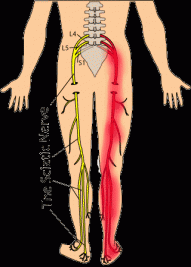Sciatica / Sciatica Pain
What is sciatica or sciatic pain?
 Sciatica or sciatic pain is characterized by pain that radiates from the lower back to the buttocks, thigh, lower leg, and foot. The sciatic nerve emerges from the lower spine, crosses the leg, and supplies nerves to the muscles and skin of the leg and foot. This nerve is the widest in the body, in addition to being the one with the greatest length. Therefore, you can be exposed to many different injuries to your lower back and pelvis, and even along your leg.
Sciatica or sciatic pain is characterized by pain that radiates from the lower back to the buttocks, thigh, lower leg, and foot. The sciatic nerve emerges from the lower spine, crosses the leg, and supplies nerves to the muscles and skin of the leg and foot. This nerve is the widest in the body, in addition to being the one with the greatest length. Therefore, you can be exposed to many different injuries to your lower back and pelvis, and even along your leg.
What can cause sciatica or sciatic pain?
Injury or inflammation of the sciatic nerve can cause pain that travels down the leg from the thigh to the foot and toes. Sciatica / sciatic pain can be caused by back injuries, arthritis irritation of the spine, or pressure on the nerve at various points along the path of the nerve.
Sciatic nerve pain may also be due to a prolapsed or herniated abnormality or protrusion of a disc in the lower back. The discs are like a padded washer that serves to cushion and separate the vertebrae (spinal bones). The affected disc can put pressure on the spinal root of the sciatic nerve. This condition is known as a herniated disc and pain can be felt throughout the lower back.
Sciatica / sciatic pain can also be the result of an enlargement of the joint processes called osteophytic hypertrophy. It can also be due to deflection and fixation of the adjacent joint surfaces that entrap the nerve in a phenomenon known as subluxation.
Sciatica / sciatic pain can also be caused when a muscle spasms, contracts abnormally, and puts pressure on the nerve. An acute injury is usually previously conditioned by prolonged or inappropriate use of the back. Occasionally, sciatica can be caused by a tension injury to the piriformis muscle in the lower buttock and thigh.
How can the chiropractic doctor and chiropractic help you with your sciatica and sciatic pain?
Chiropractic Doctors are educated and trained in the detection and care of problems that affect the spine.
Many cases of sciatica / sciatic pain lend themselves to effective correction through a chiropractic care program. Your chiropractor can provide you with a comprehensive exam and recommendations for the appropriate care of your case.
Your first visit to the chiropractor may include an x-ray to detect possible underlying pathologies and any distortion of your spine. It is possible that on this occasion the chiropractor can provide your first chiropractic adjustment to the lower spine to help reduce stress on the spinal discs, alleviate deviation of joints and adhesions, lubricate joint surfaces and restore mobility, eliminating pressure on the nerves caused by dysfunction of movement. In addition, your chiropractor can advise you on therapeutic exercises, posture management, and a complete chiropractic care program.
Once vertebral subluxation correction has begun, it usually takes some time for the pain associated with sciatica / sciatica to subside. Additional time is needed for healing, even after pain is relieved. Each individual responds differently, depending on their commitment to following an appropriate regimen prescribed by the chiropractor, the physical and emotional makeup of the patient, and the severity of the injury.
If your condition persists and requires an examination by another health care specialist, your chiropractor will refer you to him.
What can you do to help prevent sciatica / sciatica pain?
Take special care when lifting, bending over, or engaging in any task that requires physical effort.
For example, you may be carrying too much weight at one time, such as a heavy shopping bag, or even a purse, in one hand. Balance the load you carry by dividing it into small, manageable packages.
* Start a regular program of appropriate exercises to help strengthen your back and abdominal muscles. Your chiropractor can recommend the best exercise program for you.
* Have a spinal exam before starting a vigorous exercise program so as not to contribute to or exacerbate any abnormal back conditions. You should also undergo regular spinal exams to prevent new conditions that can lead to spinal problems.
* Avoid sitting for long periods of time as this position puts the weight of the upper body on the lower spinal discs.
If you have to sit for long periods of time, take regular breaks to walk, stretch, or change positions.
* Be strict in following good posture habits when standing, sitting and walking. For example, your work habits may be wrong. If you have to sit in an office all day, don't flinch, sit up straight.
* Follow the regimen recommended by your chiropractor and / or other health care specialists. Proper spinal care can help your spine remain flexible, mobile, and free from sciatica / sciatic pain.